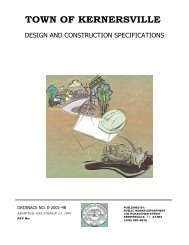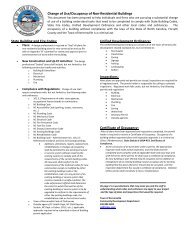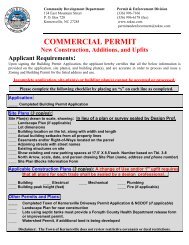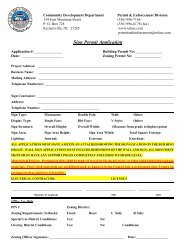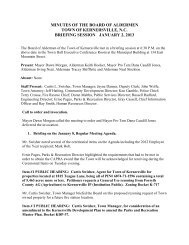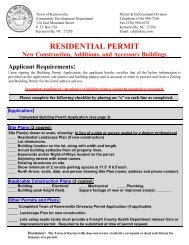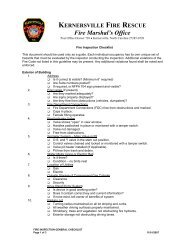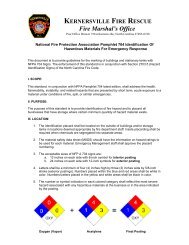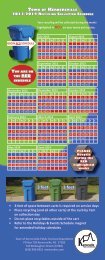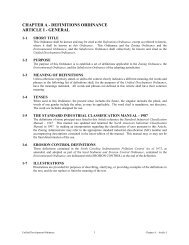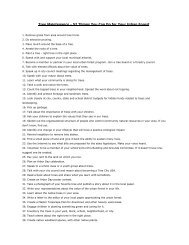Kernersville B-40 & South - Town of Kernersville
Kernersville B-40 & South - Town of Kernersville
Kernersville B-40 & South - Town of Kernersville
Create successful ePaper yourself
Turn your PDF publications into a flip-book with our unique Google optimized e-Paper software.
PROCEDURE FOR MONITORING BORROW PIT DISCHARGE:<br />
(2-20-07) 105-16, 230, 801 SP1 G181<br />
Water discharge from borrow pit sites shall not cause surface waters to exceed 50 NTUs (nephelometric<br />
turbidity unit) in streams not designated as trout waters and 10 NTUs in streams, lakes or reservoirs<br />
designated as trout waters. For lakes and reservoirs not designated as trout waters, the turbidity shall not<br />
exceed 25 NTUs. If the turbidity exceeds these levels due to natural background conditions, the existing<br />
turbidity level shall not be increased.<br />
If during any operating day, the downstream water quality exceeds the standard, the Contractor shall do<br />
all <strong>of</strong> the following:<br />
(A)<br />
(B)<br />
(C)<br />
(D)<br />
Either cease discharge or modify the discharge volume or turbidity levels to bring the downstream<br />
turbidity levels into compliance, or<br />
Evaluate the upstream conditions to determine if the exceedance <strong>of</strong> the standard is due to natural<br />
background conditions. If the background turbidity measurements exceed the standard,<br />
operation <strong>of</strong> the pit and discharge can continue as long as the stream turbidity levels are not<br />
increased due to the discharge.<br />
Measure and record the turbidity test results (time, date and sampler) at all defined sampling<br />
locations 30 minutes after startup and at a minimum, one additional sampling <strong>of</strong> all sampling<br />
locations during that 24-hour period in which the borrow pit is discharging.<br />
Notify DWQ within 24 hours <strong>of</strong> any stream turbidity standard exceedances that are not brought<br />
into compliance.<br />
During the Environmental Assessment required by Article 230-4 <strong>of</strong> the 2012 Standard Specifications, the<br />
Contractor shall define the point at which the discharge enters into the State’s surface waters and the<br />
appropriate sampling locations. Sampling locations shall include points upstream and downstream from<br />
the point at which the discharge enters these waters. Upstream sampling location shall be located so that<br />
it is not influenced by backwater conditions and represents natural background conditions. Downstream<br />
sampling location shall be located at the point where complete mixing <strong>of</strong> the discharge and receiving<br />
water has occurred.<br />
The discharge shall be closely monitored when water from the dewatering activities is introduced into<br />
jurisdictional wetlands. Any time visible sedimentation (deposition <strong>of</strong> sediment) on the wetland surface is<br />
observed, the dewatering activity will be suspended until turbidity levels in the stilling basin can be<br />
reduced to a level where sediment deposition does not occur. Staining <strong>of</strong> wetland surfaces from<br />
suspended clay particles, occurring after evaporation or infiltration, does not constitute sedimentation.<br />
No activities shall occur in wetlands that adversely affect the functioning <strong>of</strong> a wetland. Visible<br />
sedimentation will be considered an indication <strong>of</strong> possible adverse impacts on wetland use.<br />
The Project Manager will perform independent turbidity tests on a random basis. These results will be<br />
maintained in a log within the project records. Records will include, at a minimum, turbidity test results,<br />
time, date and name <strong>of</strong> sampler. Should the Department’s test results exceed those <strong>of</strong> the Contractor’s<br />
test results, an immediate test shall be performed jointly with the results superseding the previous test<br />
results <strong>of</strong> both the Department and the Contractor.<br />
The Contractor shall use the NCDOT Turbidity Reduction Options for Borrow Pits Matrix, available at<br />
http://www.ncdot.org/doh/preconstruct/ps/contracts/letting.html to plan, design, construct, and<br />
maintain BMPs to address water quality standards. Tier I Methods include stilling basins which are<br />
11509; WBS #: 3709.3.23 B<strong>40</strong> Interchange Landscape 28



